Short Book Reviews
Hanna Kryszewska, Poland
Hanna Kryszewska is a teacher, teacher trainer, trainer of trainers. She is a senior lecturer at the University of Gdańsk, and EU Teacher Training College where she trains pre-service teachers. She is co-author of resource books: Learner Based Teaching, OUP, Towards Teaching, Heinemann, The Standby Book, CUP, Language Activities for Teenagers, CUP, The Company Words Keep, DELTA Publishing, and a course book series for secondary schools: ForMat, Macmillan. She is also co-author of a video based teacher training course: Observing English Lessons. Hania is a Pilgrims trainer and editor of HLT Magazine.
E-mail: hania.kryszewska@pilgrims.co.uk
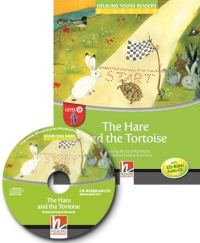
Helbling Young Readers. Classics. Big Book. Helbling Languages (2015). The Hare and the Tortoise. Retold by Richard Northcott ISBN-978-3-99045-273-18, pp 24. Helbling Big Books are part of the Helbling Young readers Series. This is a great new series of graded readers available at 5 different levels. For more information on the regular size readers go to http://old.hltmag.co.uk/jun15/pubs01.htm. As for the Big Books, the size makes the reading a more fun experience shared by the whole class, and it is a great tool for language learning. The size will attract the attention of the whole class, as the big pictures can be seen by the whole group of learners and used as a powerful visual tool combined with the language input or output. Reading together brings reading to life and will make the learners fall in love with reading, as a shared experience. The books contains ideas on how to use Big Books in class: on the inside of the cover there are five great suggestions for using the Big Books in five separate sessions, and for more ideas on how to use the stories and to download an MP3 audio the teachers can go to: www.helblingyoungreaders.com
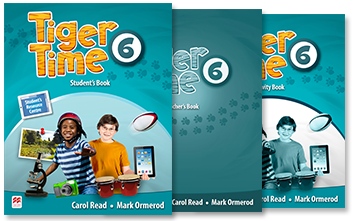
Tiger Time 1-6. Student’s Books. C. Read and M. Ormerod. (2015) Macmillan. ISBN e.g. 978-0-230-48390--6, pp.64. Tiger Time is a six level English language course aimed at young learners of English. Language is taught in natural contexts through funny stories told in different styles, chants and songs. The course slowly builds up vocabulary, grammar and language skills. It also gradually introduces elements of CLIL, culture and involvement in projects. The course grows up together with learners; the layout, content and tasks become more mature. The activities are well staged and are very practical. The course is accompanied by a Presentation Kit and Teacher's Resource Centre which help teachers create their lessons and adapt the course to the learners’ needs and various classroom situations. The learners have access to a Student's Resource Centre which offers a home-school connection with additional activities (each student’s book comes with an individual access code). The course is a new version of Tiger Tales first published by Macmillan in 2013, but I am unable to jusge how much the two courses differ.
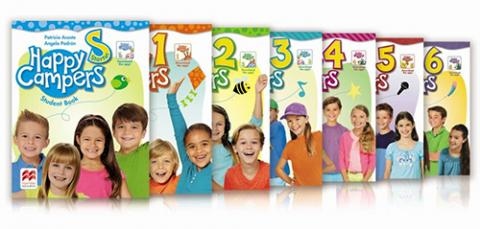
Happy Campers Starter - 6. Student’s Books. (depending on the part P. Acosta, A. Padron, A. Llanas, L. Williams, G. D. Maggioli and L. Painter-Farrell. (2015) Macmillan. ISBN e.g. 978-0-230-47249-5, pp.87 (student’s book) + pp16 (workbook). Happy Campers is a seven level American English language course aimed at young learners of English. Language is taught in natural contexts and there is ample opportunity to practice new language through fun activities. The use of music,chants, cheers and echoes helps learners memorise language, perfect and refine their use of langaueg, and master good pronunciation. The books have a flipbook design, one side student’s book, and after your flip there is the work book (called The Language Lodge). There is also an additional skills book with materials for extra practice, teacher training workshops and practical tips to help classroom management. There are also digital presentation tools with animated grammar and vocabulary presentations, and a downloadable app for each level.
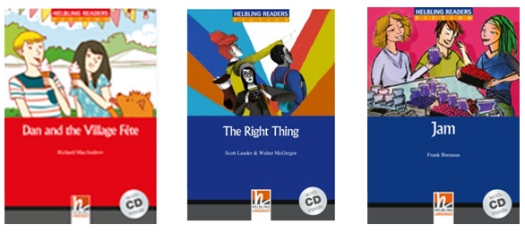
Helbling Readers Fiction. Dan and the Village Fete. R. MacAndrew. Helbling Languages (2015). ISBN-978-3-85272-787-5, pp 72. The Right Thing. S. Lauder and W. McGregor. Helbling Languages (2015). ISBN-978-3-99045-256-1, pp 80. Jam. F. Brennan. Helbling Languages (2015). ISBN-978-3-99045-255-4, pp 68. Books in this series of graded reading materials for teenagers come at five levels, for example Dan and the Village Fete is pitched at level 1 (A1 Breakthrough/ KET), Jam at level 4 (A2 Waystage - B1 Threshold/ PET) while The Right Thing at level 5 (B1 Threshold/ PET). The stories are a good read; Dan and the Village Fete is about relationships, helping friends in need who are bullied, The Right Thing is about solving a mystery and international spy story, while Jam is about a mum who finds it hard to make ends meet, especially when her teenage kids keep making all sorts of financial demands. When she gets an offer which involves making some special jam there are more problems than advantages. The stories are a good read and they each have a message for the readers. The learners become familiar with some lexis in the pre-reading tasks. As they read the story they can see the new words marked with a dot (and explained at the bottom of the page); they can also listen to the whole story and do some activities available on an accompanying audio CD. Finally there are some additional after reading activities and more activities to be found at http://www.helbling-ezone.com/. The illustrations are pleasant to the eye, and I am sure the books will be popular among young learners as additional reading material, just like the other titles in the series. For more on the series go to Short Book Reviews October 2014 and Short Book Reviews October 2013
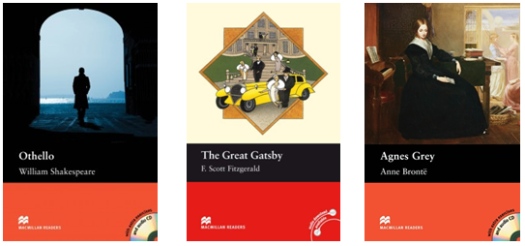
Macmillan Readers. Othello. W. Shakespeare retold by C. Rose. (2015). ISBN 978-0-230-47020-0, pp 99. The Great Gatsby. F. Scott. Fitzgerald retold by M. Tarner. (2015). ISBN 978-0-230-48723-9, pp 84. Agnes Grey. A. Bronte retold by H. Holwill. (2015). ISBN 978-0-230-47027-9, pp 96. The Macmillan Readers series is well established on the ELT market. It provides a variety of extensive reading texts at six levels. The titles in question are retold versions of classics at Intermediate (Othello, The Great Gatsby) and Upper Intermediate levels (Agnes Grey). The readers do not follow the same template, and although they start with some background information it may be of different nature like: background information about the author and/ or the original text, geographical information or some other relevant comments. The readers come with extra reading comprehension, vocabulary and grammar extercises, an audio CD (or audio download to be bought online), and free resources online with worksheets, tests and answer keys. The readers are a very good way to introduce English literature and culture to ELT classes.
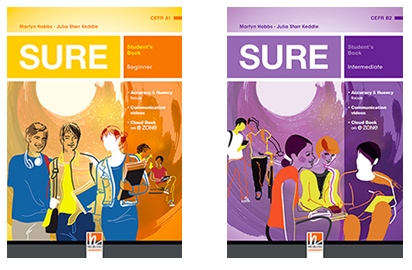
Sure: Student’s Book. Beginner. Martyn Hobbs and Julia Starr Keddle. Helbling Languages (2015) ISBN 978-3-99045-064-2 pp. 178. Student’s Book and Workbook Intermediate. Martyn Hobbs and Julia Starr Keddle. Helbling Languages (2015) ISBN 978-3-855272-759-, pp.272. These two books are new parts of a brand new and truly innovative four level teenage course ranging from beginner to intermediate levels. The course addresses contemporary themes and through these topics presents grammar structures and lexis, and teaches the four language skills. The course has a strong focus on accuracy, fluency, communication and natural language. The topics also address cultural issues and CLIL (Content and Language Integrated Learning). The learners develop their learning and study skills, and learner autonomy by using digital resources (each book comes with an access code for online resources – the so called e-zone). The online resources in the Sure Cloud contain an interactive version of the student’s book and workbook, with all the audio and video stories, and an option to take notes. When doing exercises, learners can check their success rate themselves. There are also resources and interactive activities for single student access in the Online Training. Cyber Homework consists of interactive activities assigned by the teacher within a virtual classroom. The Student’s Book and Workbook are one publication, and the course is complete with a teacher’s book, audio CD’s (in British or America English) DVD’s, a Testbuilder CD-ROM.
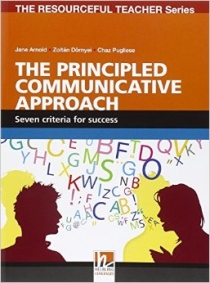
The Principled Communicative Approach. Seven criteria for success. J. Arnold, Z. Dornyei and C. Pugliese. Helbling Languages. (2015). ISBN 978-3-85272-938-1, pp 148. This book has been published in The Resourceful Teacher Series which is written by prominent figures in English Language Teaching. Communicative Language Teaching (CLT) entered the ELT scene in the seventies. Since then it has enjoyed varying degrees of popularity, however, it seems that every course book blurb says that the course is communicative. We hear the term so often that it has almost lost its meaning. The book in question takes a fresh view of the communicative approach taking into account most recent research in psychology and linguistics. In the introduction the authors explain how they understand the term principled communicative approach (PCA) , they explain the need for a new approach to CLT, the role of implicit versus explicit learning, and discuss the steps through which learners reach communicative fluency. In the introduction part I strongly recommend the section devoted to the seven main principles of PCA. The series is renown for its innovative approach and great activities which are explained step by step, and are ready to be used in the class. This book is no exeption, and offers 75 practical classroom activities. Highly recommended.
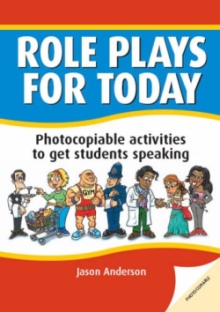
Role Plays for Today. Photocopiable activities to get students speaking. J. Anderson. (2006) DELTA Publishing. ISBN 978-1-900783-99-6, pp. 89. This photocopiable resource book for classroom use is aimed at language classes in which students practise their speaking and communicative skills. Although the book was published almost 10 years ago it is worth reminding or telling HLT readers of its existence, especially in the light of the new publications on Communicative Language Teaching – CLT (see review above). The book contains 40 photocopiable ideas and relevant materials which involve genuine communication between the learners. The activities involve pairwork, groupwork and whole class interaction. The activities can be used to liven up coursebook-based lessons, and to promote authentic interaction and competition. The activities involve using functional language, specific grammar structures and lexis. The learners also practise genuine communication and comprehension skills when cracking the rules of the activities. The activities fall into four subject areas: services, shopping, social life and lifestyle; the fifth section contains creative role plays. The activities are pitched between elementary to advanced levels, and the levels are clearly indicated. You can dowload sample pages from:
www.deltapublishing.co.uk/content/pdf/role-plays-for-today/Role_Plays_downloadable_pages.pdf
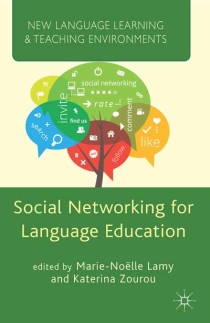
Social Networking for Language Education. ed. M-N. Lamy and K. Zourou. (2013) Palgrave Macmillan. ISBN 978-1-137-02337-7, pp. 238. This collection of texts will be of great interest to those who are interested in social media and networking for language teaching and learning. In the publishing market there are more and more publications which contain practical ideas for implementing social media in ELT. Also looking at conferences it can be seen that there is a lot of interest in the subject and a need find out more. We can also observe that recently published coursebooks try to implement the use of social media in the ELT class and outside the class. However, little is said about theoretical perspectives and empirical studies on the subject. The contributions to the book look at various communities and how they socialise using the available media. The book is divided into four parts. Part I looks at social network sites (SNS) and the impact they have on the group dynamics and feeling of identity. Part II is devoted to pedagogy and good practice underpinning the use of social media. Part III examines the benfits and challenges, while Part IV offers insights from research and practice. Using social media is changing the way we communicate, teach and learn. They are here to stay, and books like this one help us to understand the nature, mechanisms and benefits of this relatively new phenomenon.

Please check the Methodology and Language for Primary Teachers course at Pilgrims website.
Please check the Methodology and Language for Secondary Teachers course at Pilgrims website.
Please check the Teaching Advanced Students course at Pilgrims website.
Please check the Teaching Languages Using Technologies course at Pilgrims website.


|